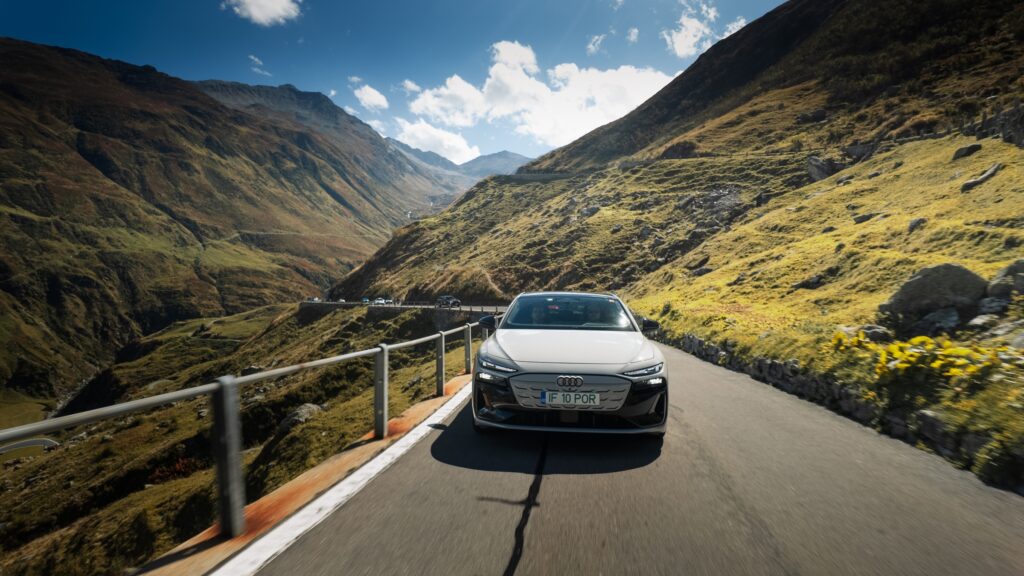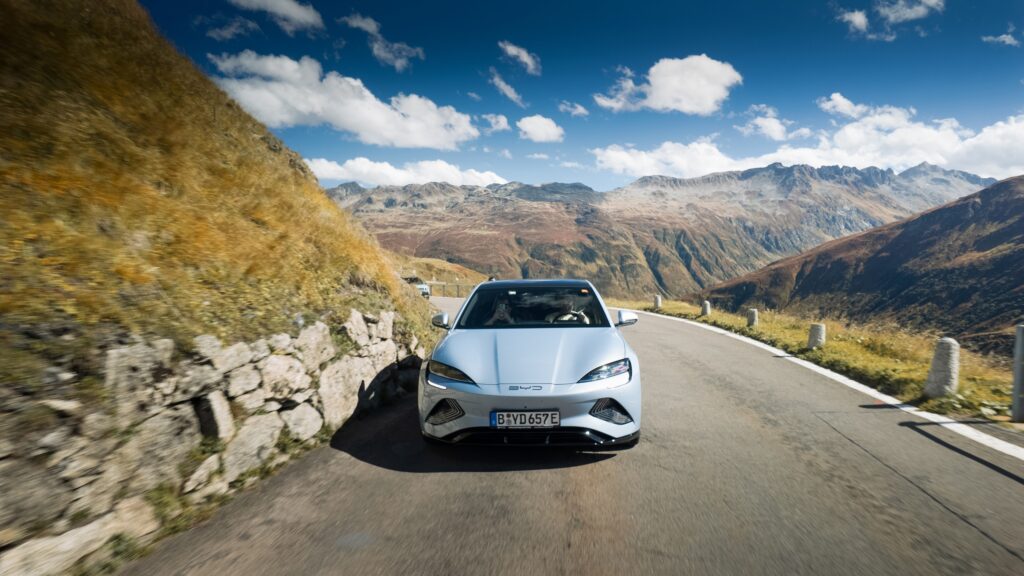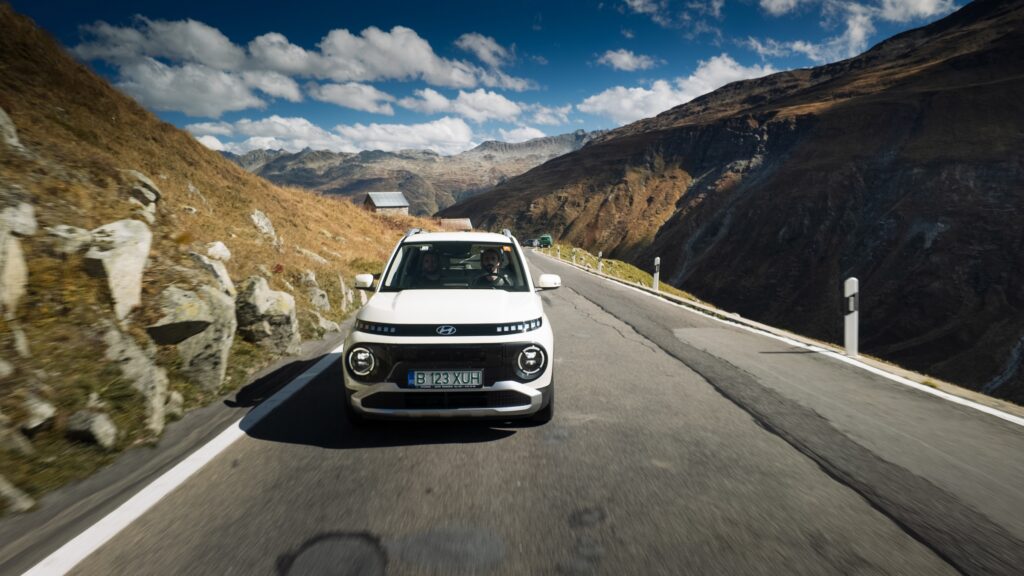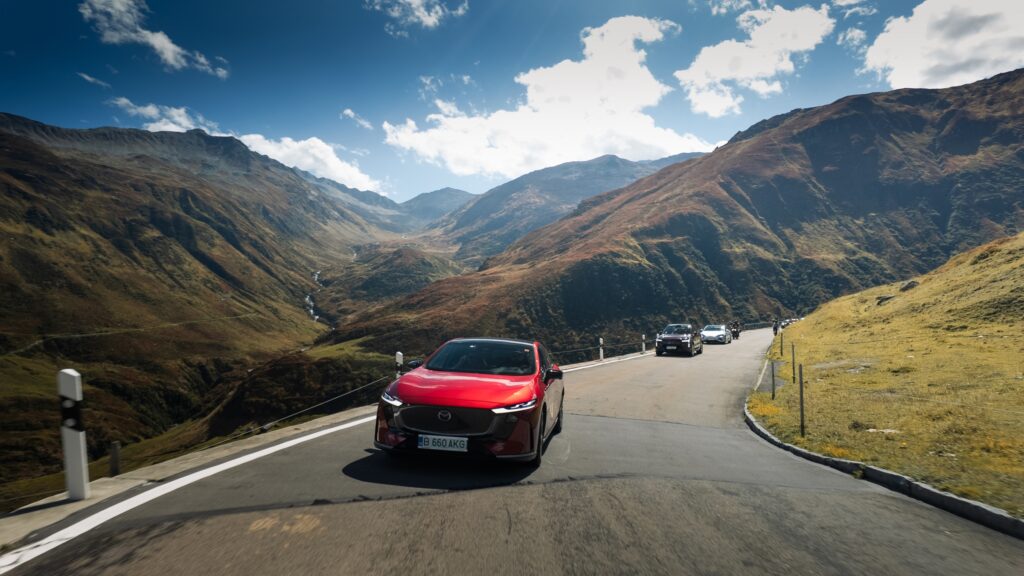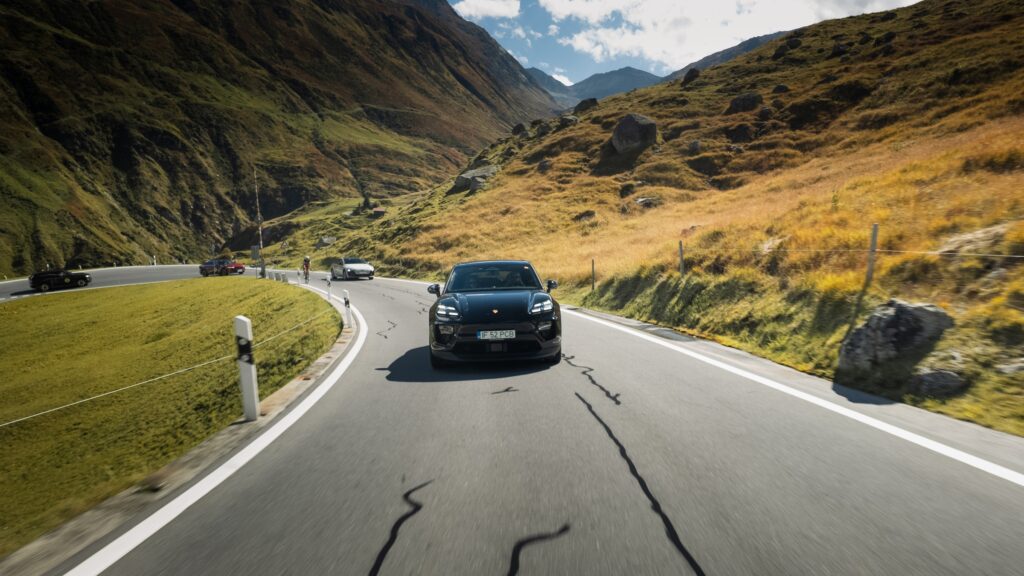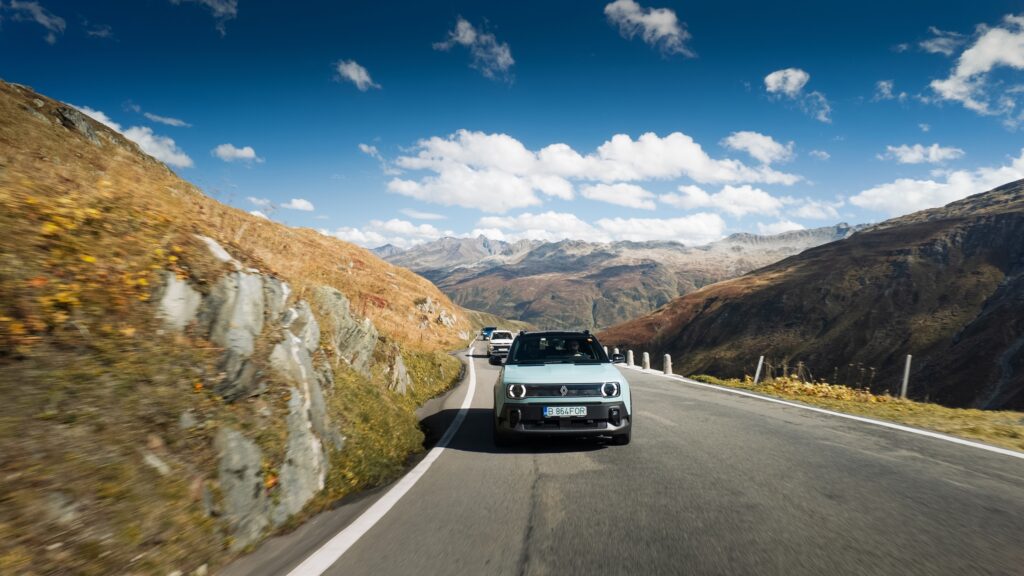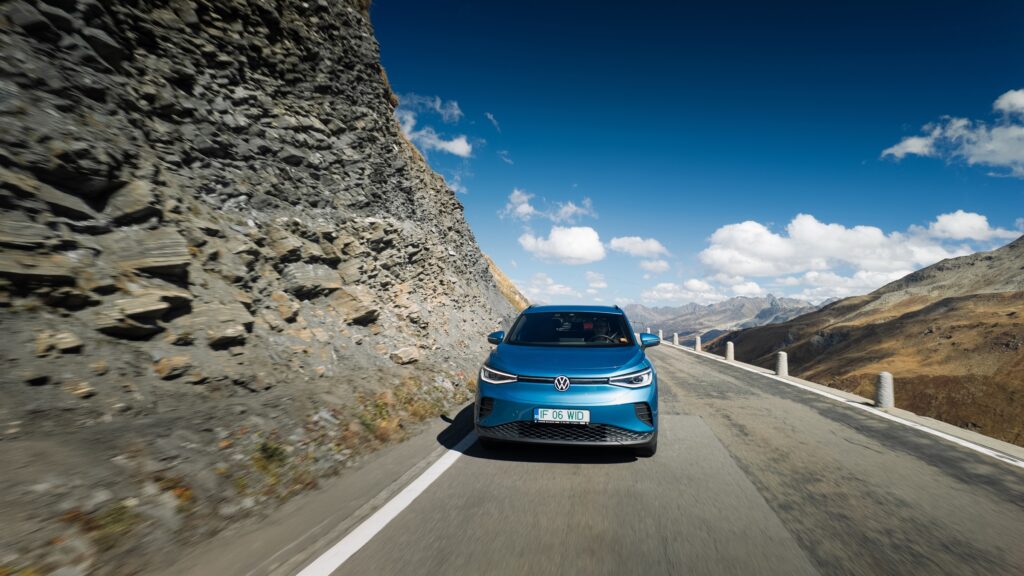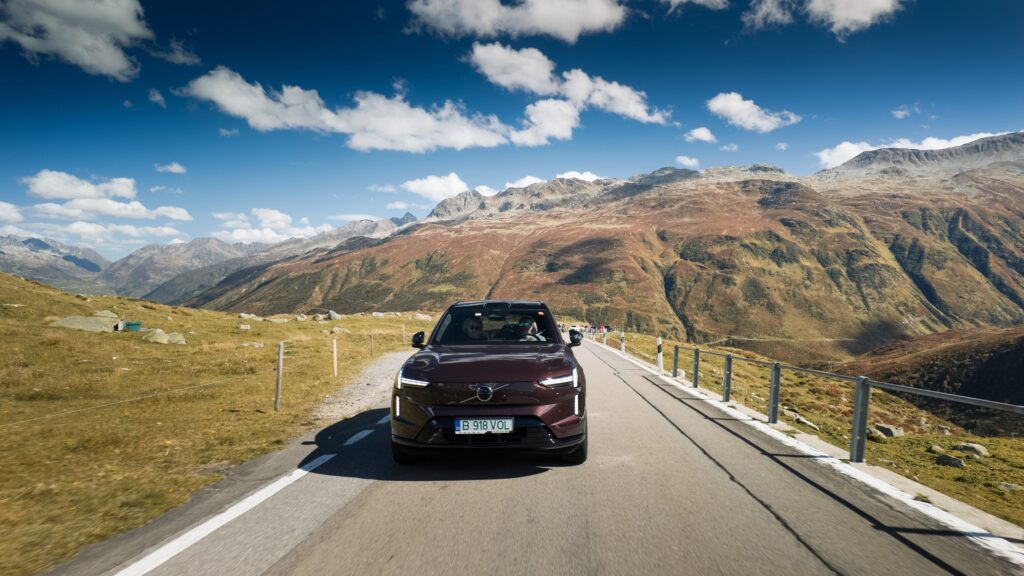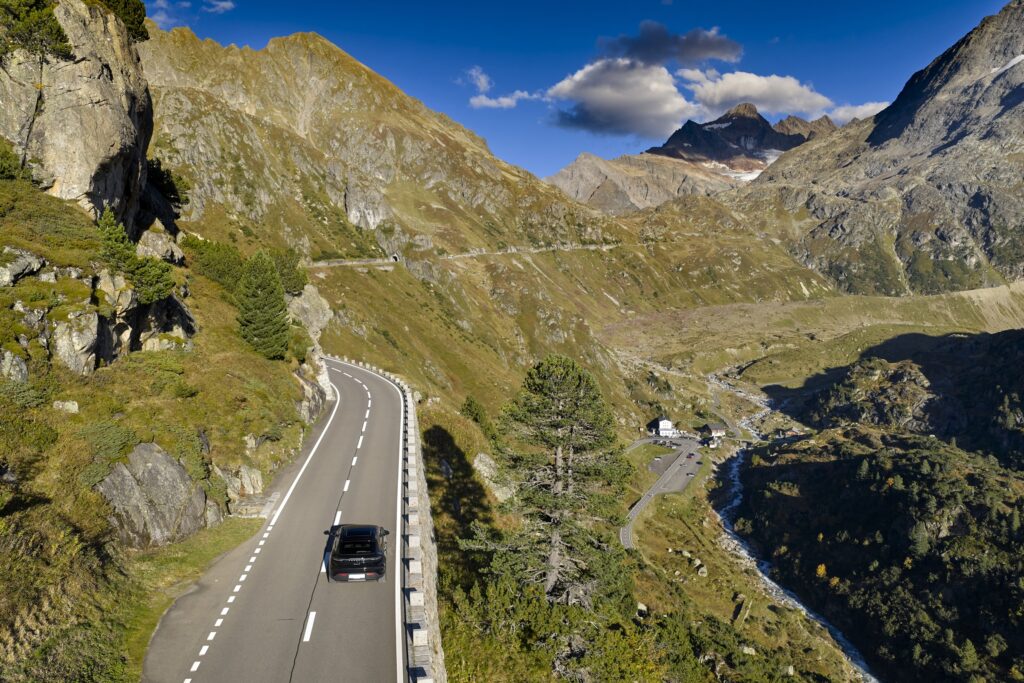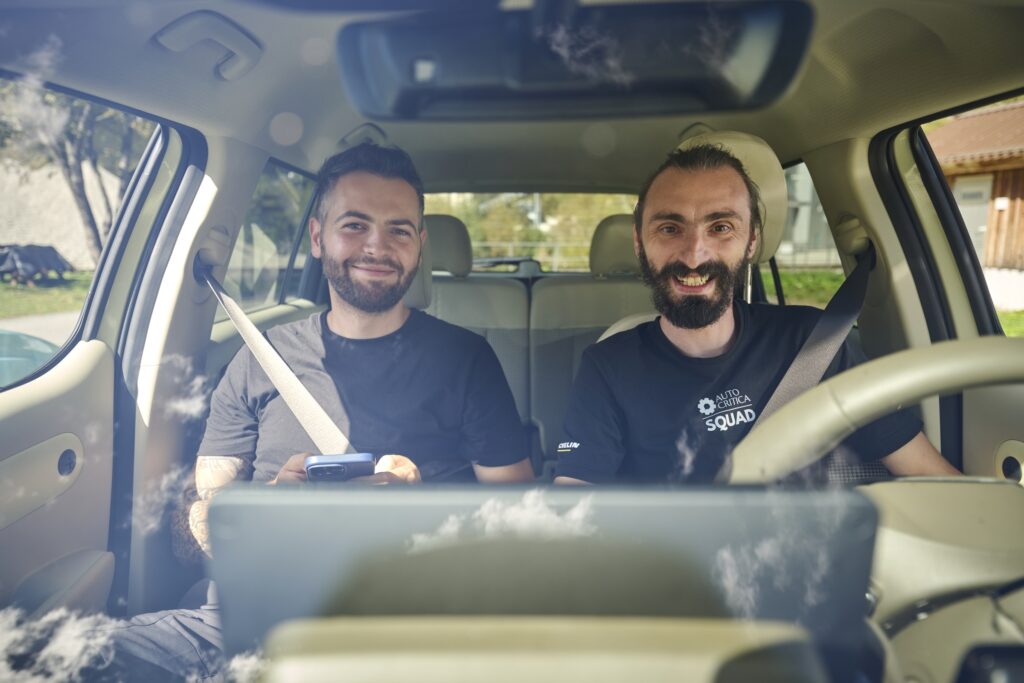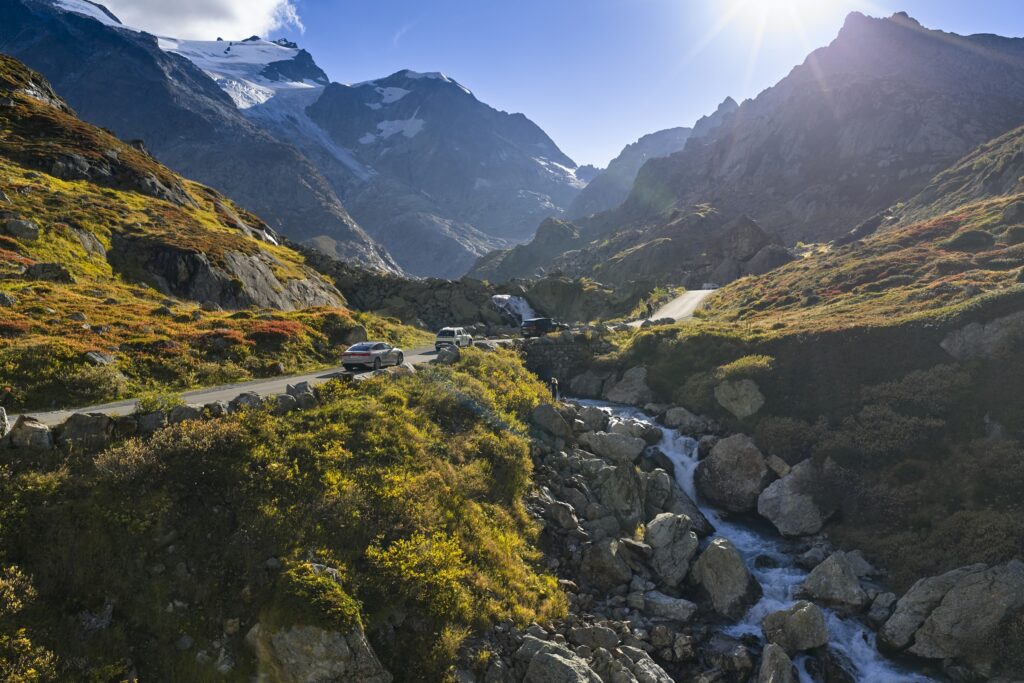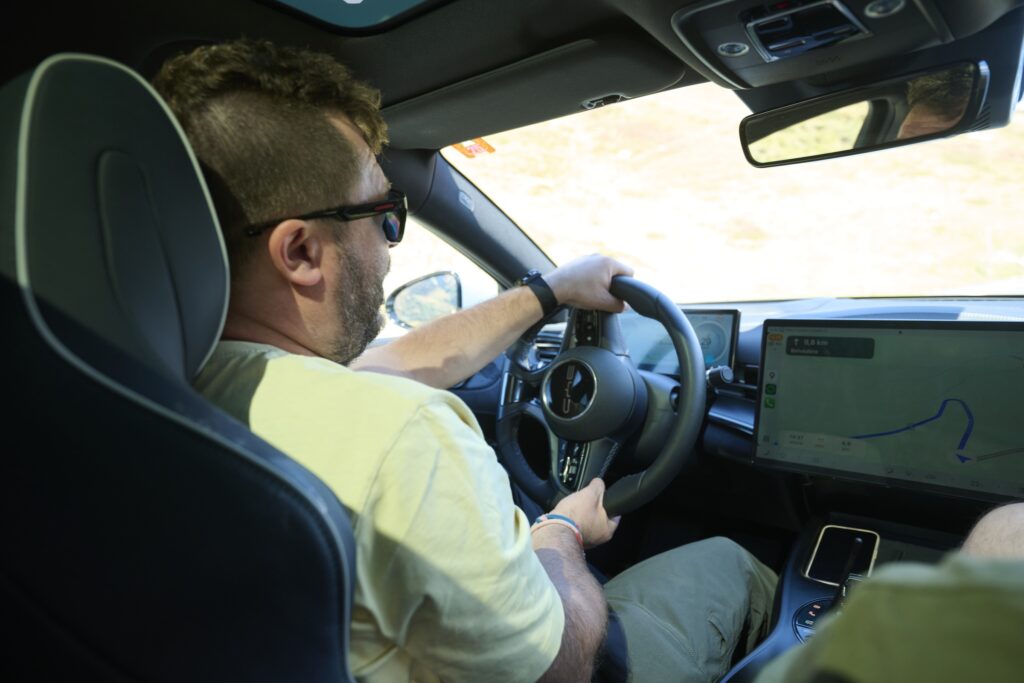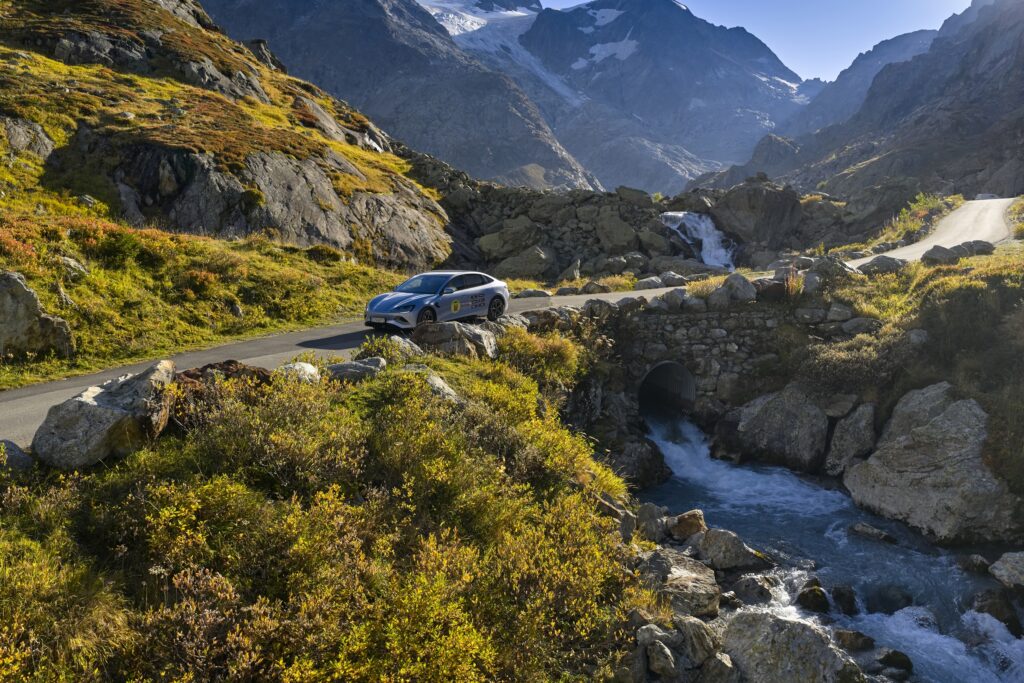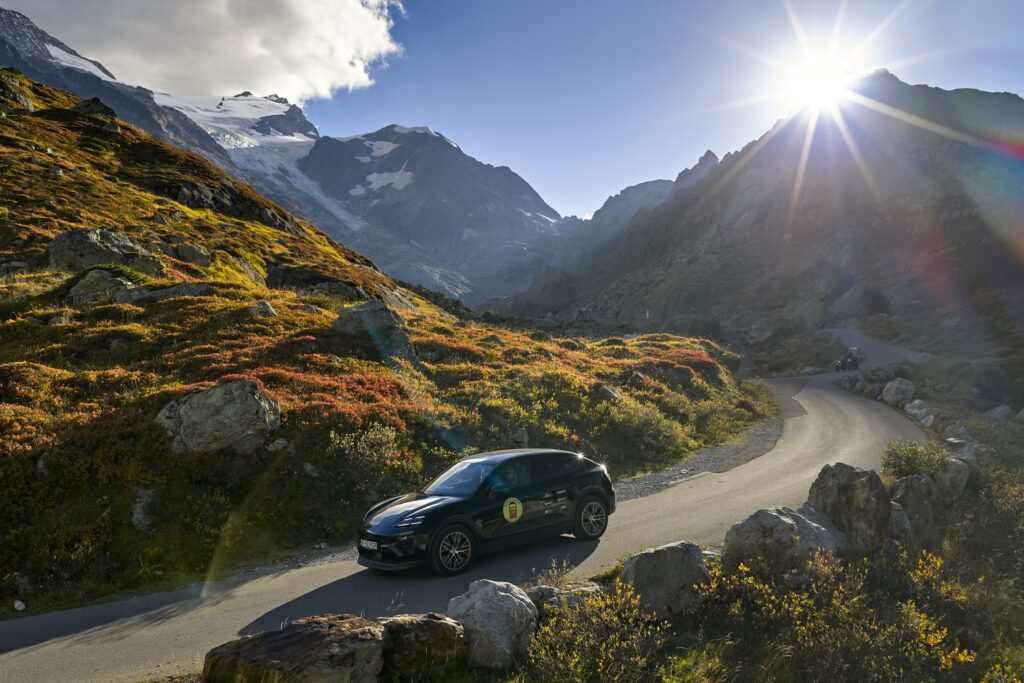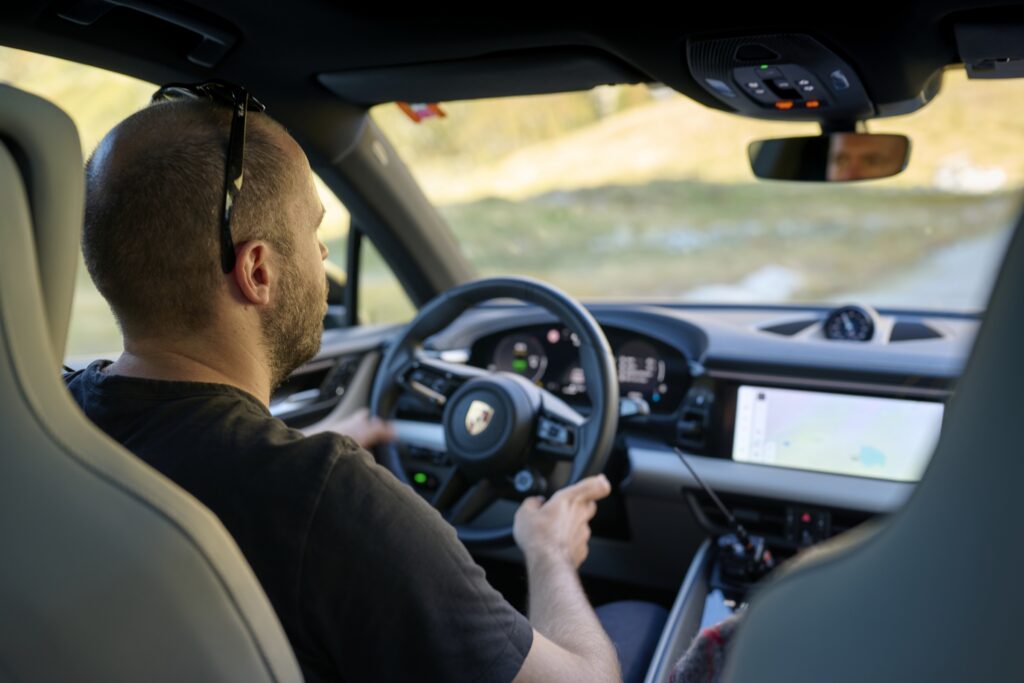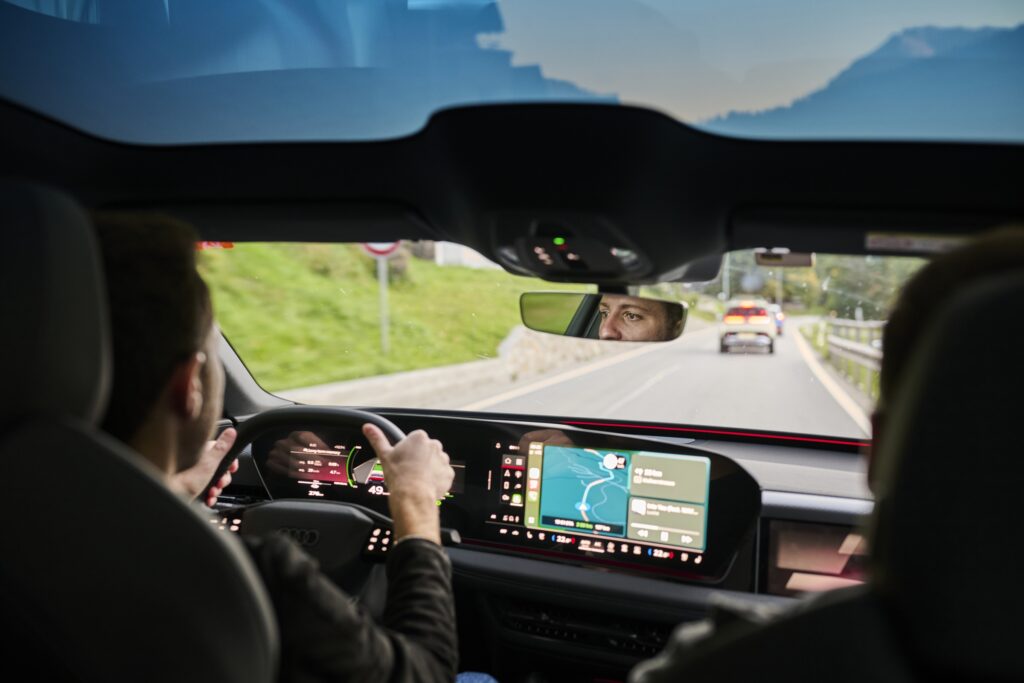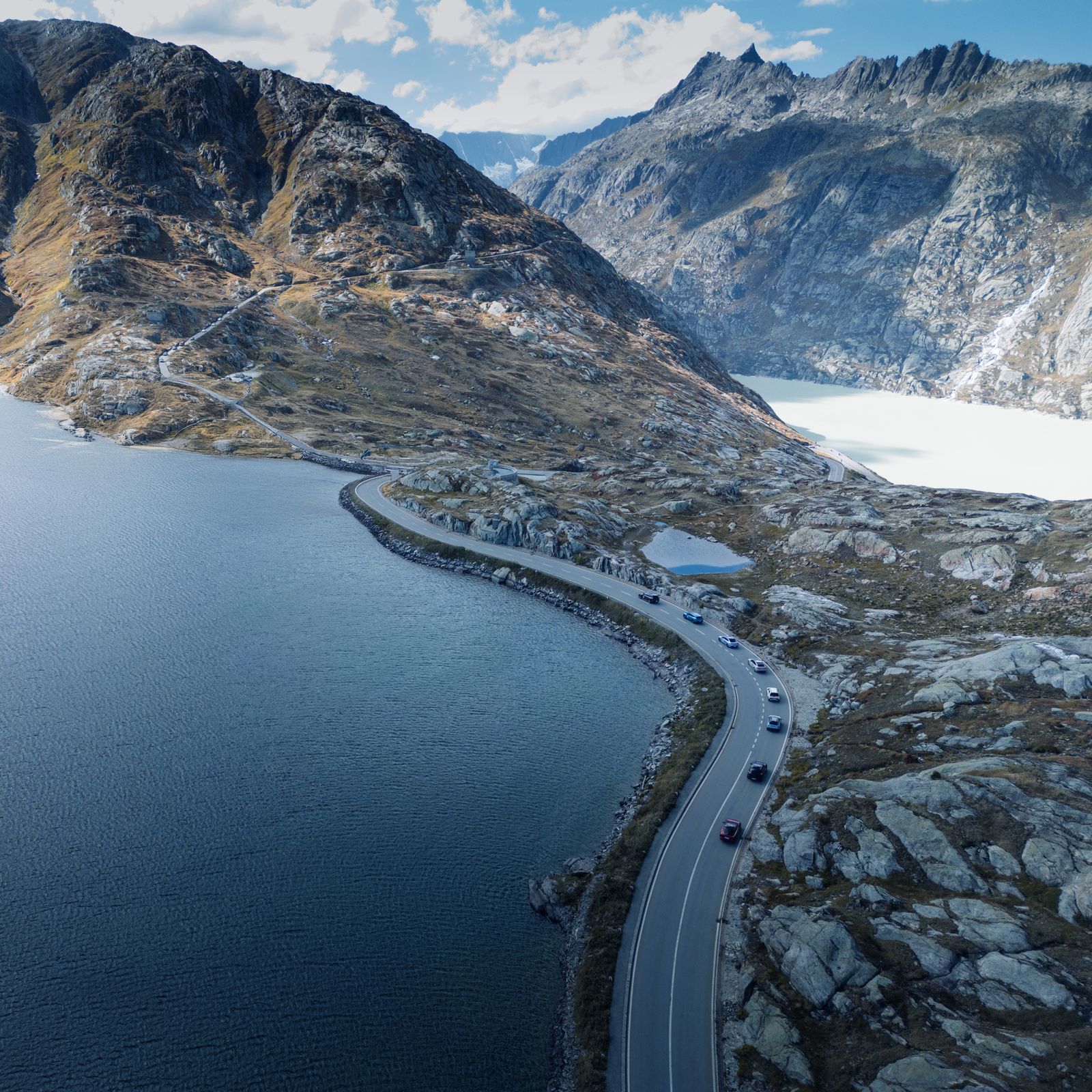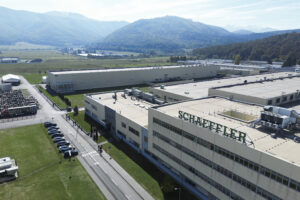I’m trying to imagine what it was like back when these passes didn’t exist. When people looked up at the mountain and wondered what was beyond. We’re at this point in evolution today because over time our species has gone beyond just wondering. It climbed these mountains, dug and built these mountain passes. And so these bridges were born, bridges that then connected the here with the hereafter, bridges that allowed migration, trade, communication.
The explorer in me wished he had no preview of what was to come. Probably self-preservation forced me to take a peek. And so I began to build ecstasy, anticipation, to discover that I was a kid who was about to encounter something. In this case, the kid in me was waiting to get to where he saw Sean Connery in Goldfinger, where 007 used an Aston Martin DB5 to civilize a Ford Mustang.

We started the day with the promise of superbly-painted kilometers. But it wasn’t just a promise, it was a certainty. The day’s first azimuth was the Furka Pass, a mountain road that reaches up to an altitude of 2,429 meters.
A Trio of Passes
Furka Pass is one of the highest and most beautiful mountain passes in Switzerland. It traces its route through the cantons of Valais and Uri and is considered one of the most dangerous routes in Europe.
Its existence as a ‘vulnerability’ in the massive stone wall is documented from the time of the Roman Empire when it was discovered to be a place through which troops and goods could be transported. Something that can be truly attributed to human tradition appears somewhere around the 13th century: a mule path, which allowed this passage to evolve into a constant route for trade in salt, wine, furs and grain. In 1964 construction began on the Hospental to Oberwald road, and in 1866 it was officially opened (some sources say 1867). A 34-kilometer route. I would also like to mention that in 1921 the pass was traveled for the first time by a mail bus.
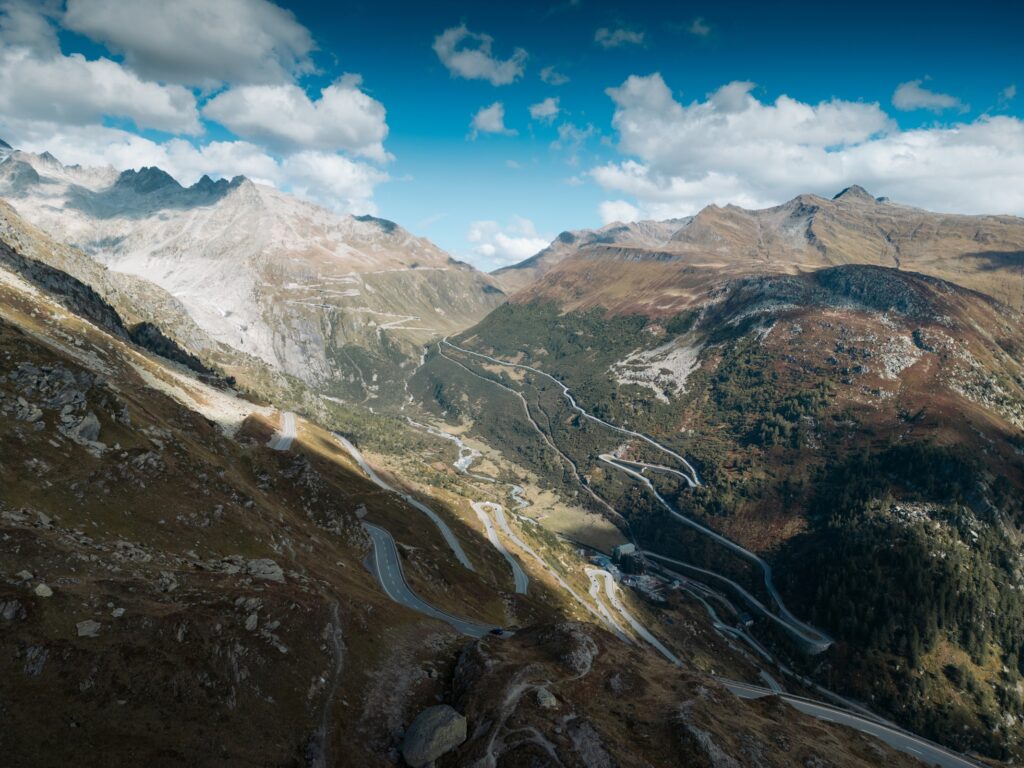
While driving along this scenic road you can enjoy views of the Ron glacier, the Schöllenenen gorge and the Galenstock peak, which rises to an altitude of 3,583 meters.
And now that we’re driving, I’d like to go into a little more detail. It’s a narrow and extremely busy pass. I wish I had stopped at the James Bond turn, but surprisingly it’s a place of pilgrimage. It’s a narrow road, so narrow in places that cars have to alternate. And the number of motorcyclists is overwhelming. A chaos at first sight, but one in which everyone is paying attention to others around them, and in that process, you become part of a sort of family, part of an organism. I must admit, it was a new form of manifestation for me, no honking, no egos, no muscle flexing, no futile need to gain a meter in front of the other.
Then we stepped onto the Grimsel Pass which took us up to 2,164 meters. Much quieter, not so many motorcyclists, but if you get here a lot of caution and courtesy towards cyclists. Grimsel Pass is part of the Aare Route. The Aare route follows Switzerland’s largest river from the small glacial lake on the Grimsel Pass to its confluence with the Rhine, passing through the Aare Gorge to enter the Mediterranean landscape. Cyclists? Yes, because this route is part of the eighth stage of the 305 km Swiss national cycling circuit. There are nine stages totaling 3,285 kilometers. And this section has been included several times in the Tour de Suisse race.
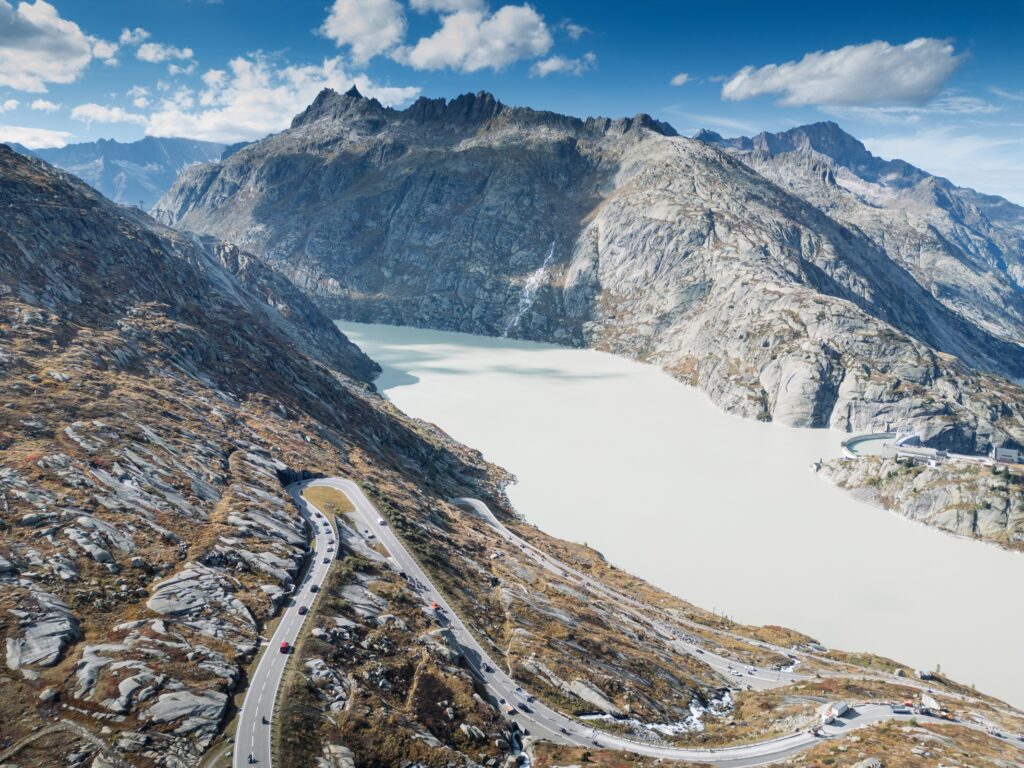
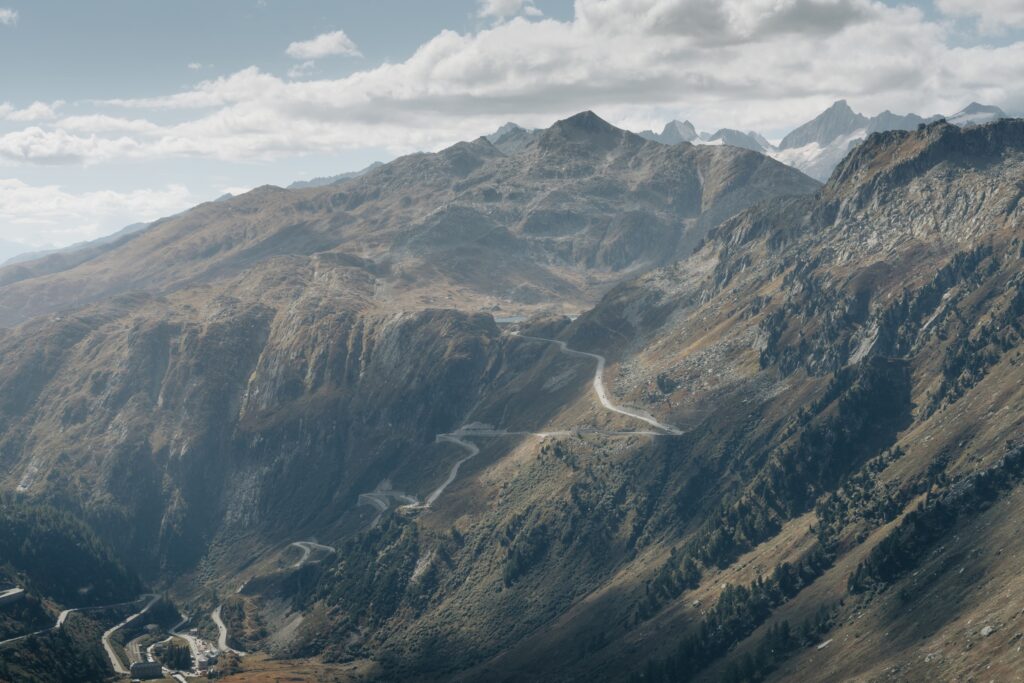
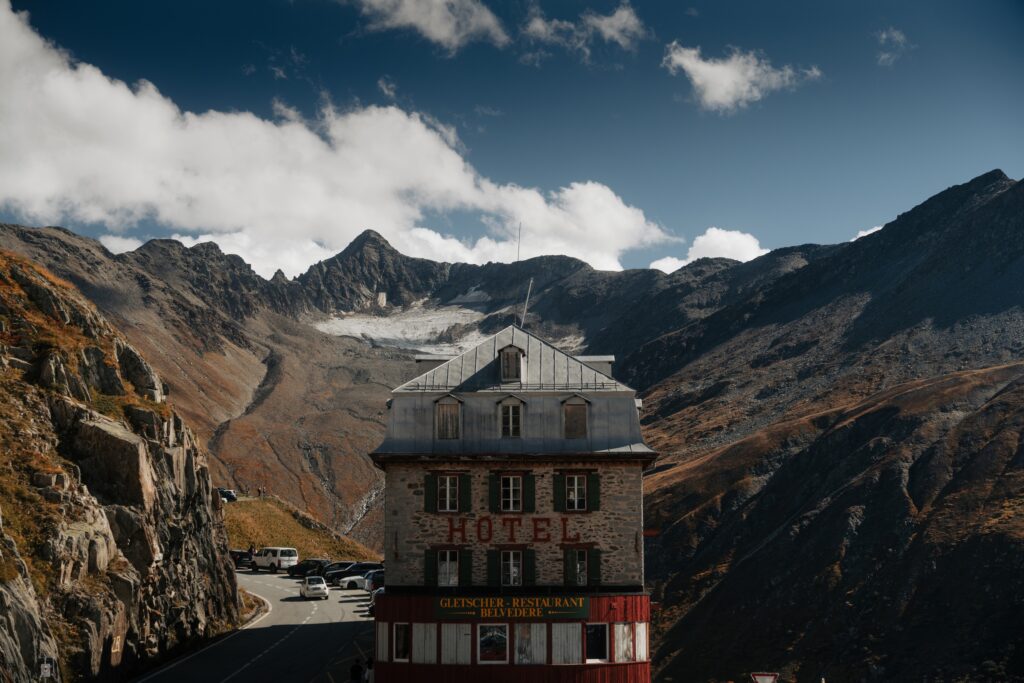
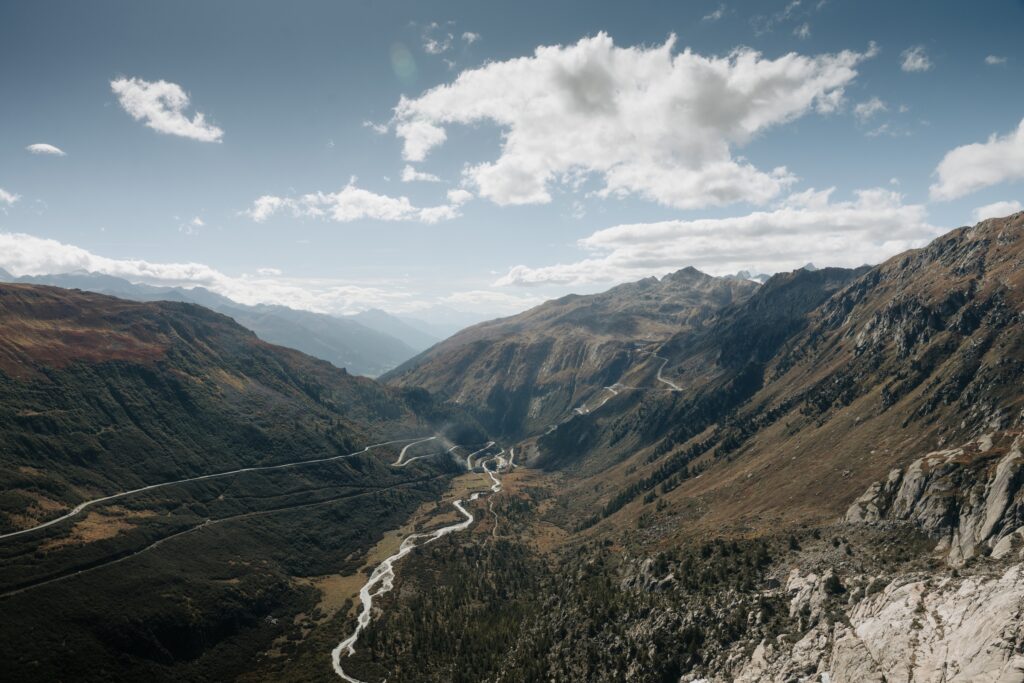
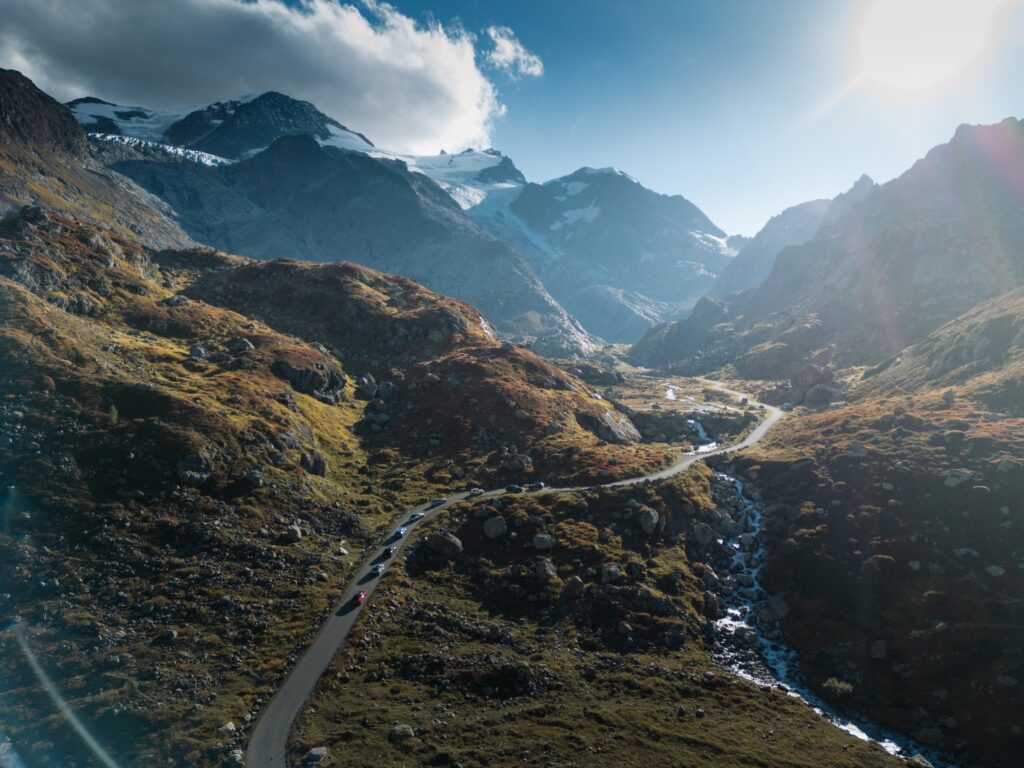
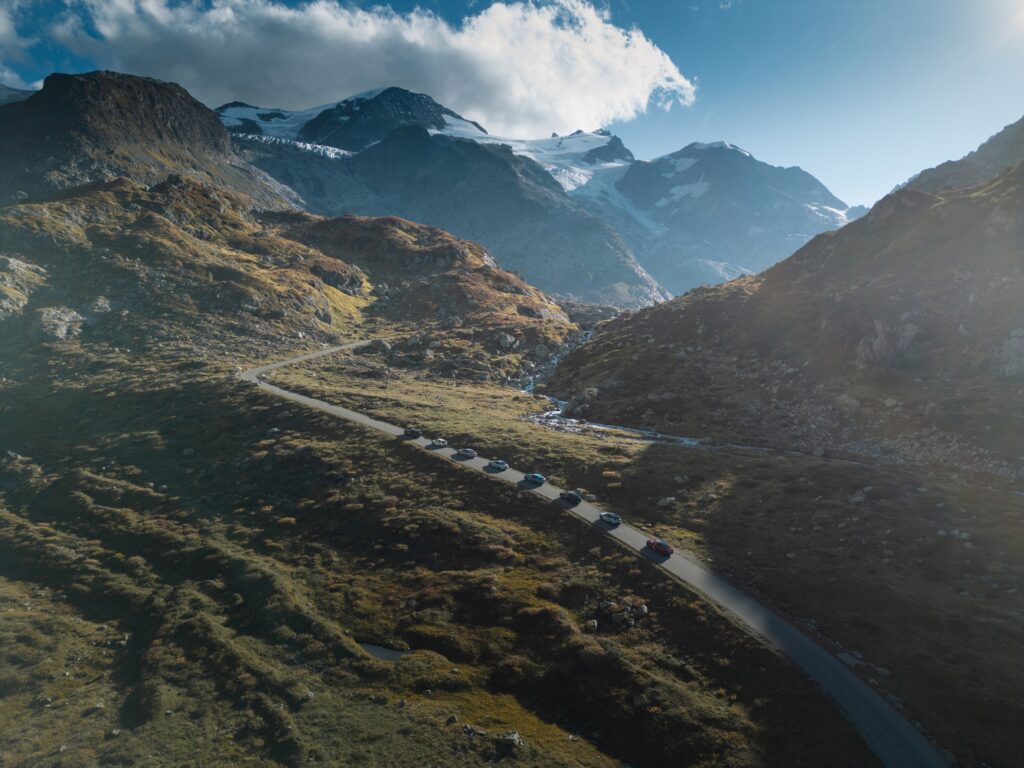
The earliest complete documentation of this pass dates back to the 14th century when three towns – Interlaken, Thun and Bern – signed an agreement guaranteeing protection to mule caravans carrying goods. Cheese and cattle went south, while grain, wine and olive oil went north.
We continued our way through Susten Pass. Documents dating back to the 17th century attest to the existence of a mule trade route through Susten Pass, but this was never a very important trade route. Religious differences, however, gave the pass a certain strategic importance, and it was here that the construction of fortifications and barriers in the Meien Valley began in 1618. In the war years 1798 and 1799, when the French “exported” some revolution to the Swiss lands as well, the Susten Pass was used as an access route by the French.
In 1938, the federal government and the cantons of Bern and Uri agreed that the road needed to be modernized for both commercial and defensive reasons as World War II was about to begin. The road was under reconstruction during the war, from 1938 to 1946. At the top you’ll find a plaque marked “1938 – 1946, In ernster Zeit dem Frieden geweiht”. Born out of conflict and dedicated to peace.
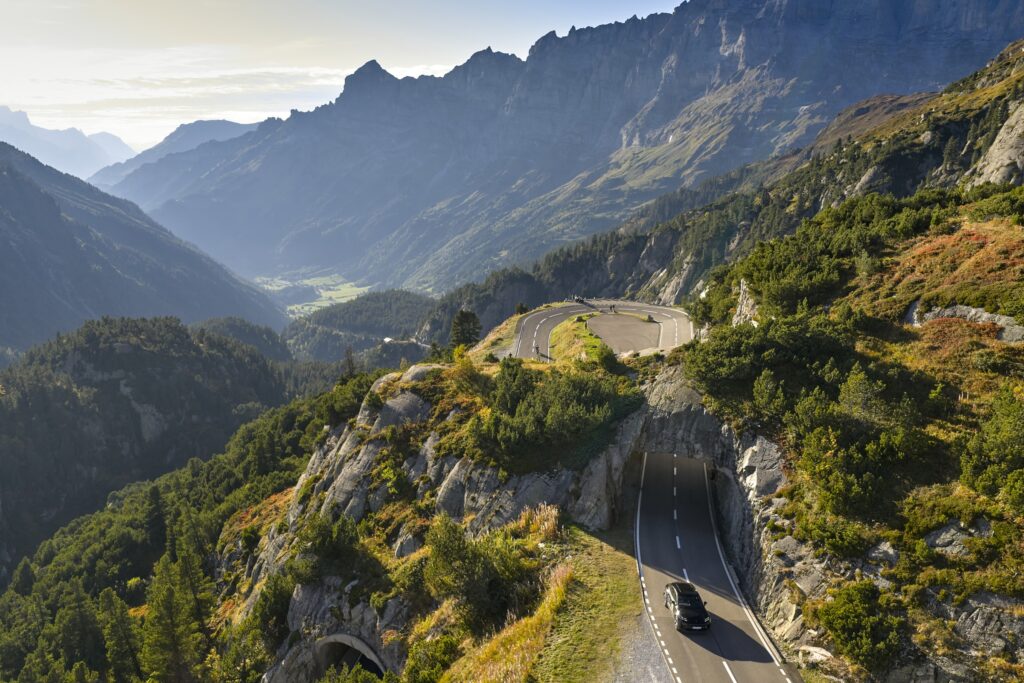
People know how to operate a motorized vehicle, whether electric or fitted with an ICE. I’ve never seen a car stopped in the middle of a hairpin because the person behind the wheel ran out of steam in third gear on the uphill. You sense in the air that it’s a place where most of the people who come there love to drive, and this is more than obvious if I did a census of the motorized vehicles encountered on these passes. I can tell you I have not seen such diversity at any car show I have visited.
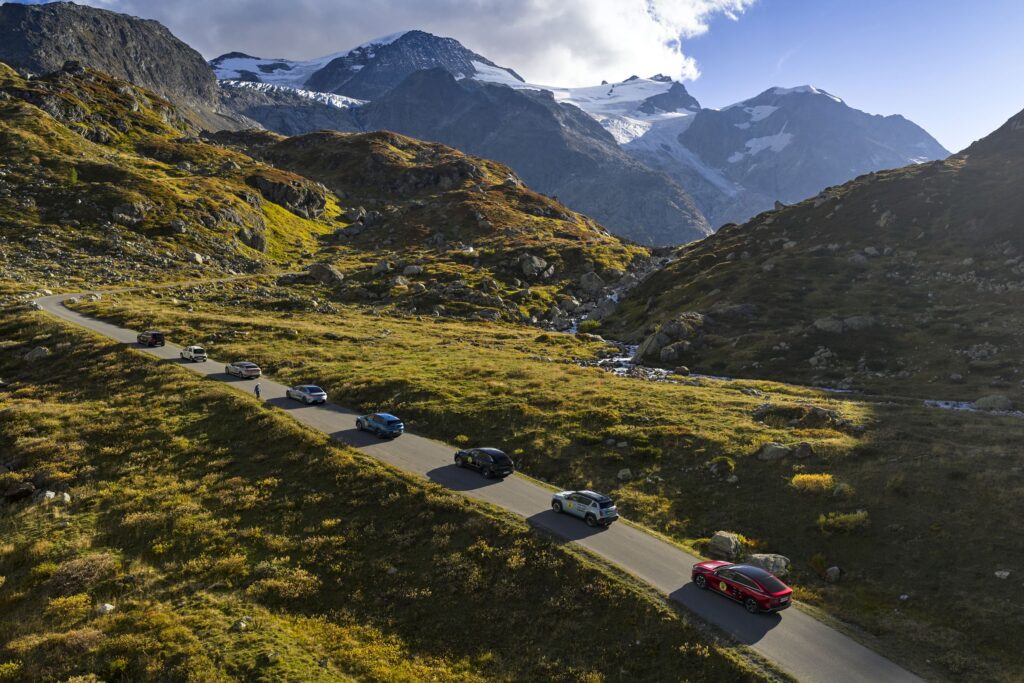
And the electric models were not curiosities or rarities, they were a natural part of the landscape. You’ll discover in the fact sheets that summarize the evolution of each model that this three-pass day was the most relaxed day in terms of consumption and range for each model. OMV eMotion mediated our socializing with 350 kW stations, and we, the drivers and co-drivers, we did our “charging” on the go, behind the wheel. But know that we saw charging stations at 2,000 meters.
What a fortunate species we are to have somehow reached the top of the food chain and to be able to savor beauty in a way other than organically. I hope we also have the wisdom to preserve it and pass it on to those to come.
Human by Schaeffler
I discovered Schaeffler during Eurocharge 2024. After last year’s visit to a few centers in Brașov, I remember falling asleep a little harder at night. A little chastened by my ignorance, a little more impressed by how many things are born and produced under the brand.
What I can say is that the Schaeffler portfolio is more than impressive, but next I would like to talk about something else. Let’s take a break from CSC, BMS and talk about other things Schaeffler has done.
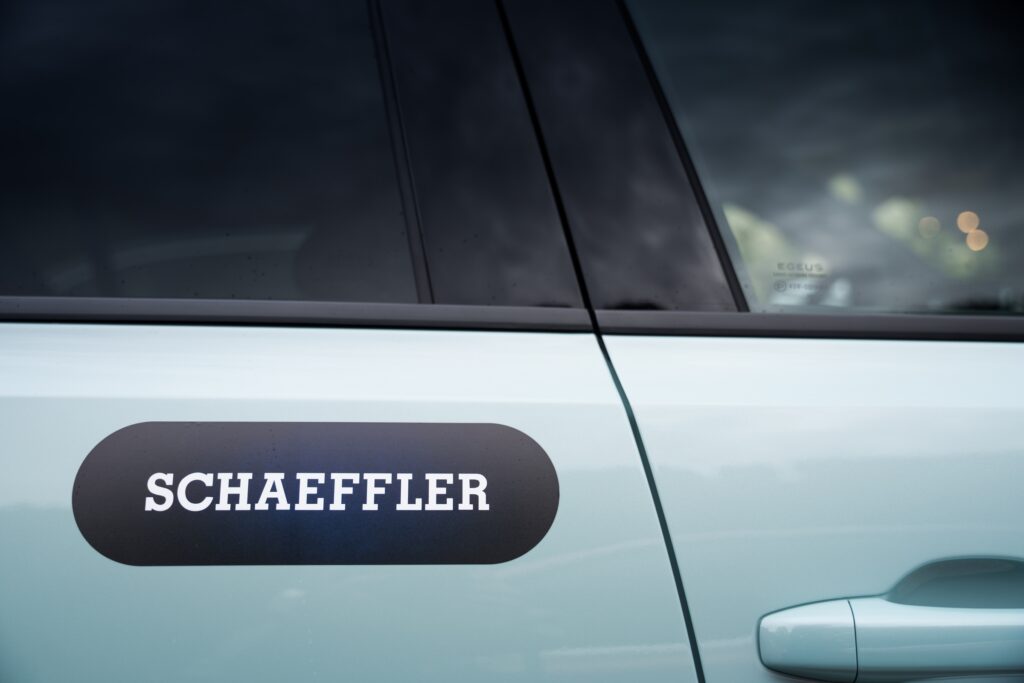
For more than 100 children from foster homes, 250 children from disadvantaged areas and families in need, Schaeffler is the place where letters to Santa Claus arrive. Employees donated more than 3,350 toys, as well as clothes, shoes and school supplies. And the company donated more than 15,000 euros to support charitable, educational and health initiatives in the communities around Schaeffler locations.
In spring, the German Vocational School Kronstadt (SPGK) opened a state-of-the-art dormitory in Brașov to accommodate the growing number of students. As a founding partner, Schaeffler plays a key role in training the school’s students, many of whom become the next generation of skilled workers in the technology and industrial sectors.
Schaeffler’s partnership with SPGK underlines the company’s dedication to training a skilled workforce through the dual education system. Currently, Schaeffler trains 400 of SPGK’s 700 apprentices, giving them hands-on experience in its training center under the guidance of dedicated instructors. The new dormitory, equipped with 306 beds and modern facilities such as study and recreation areas, aligns with Schaeffler’s objectives by creating an environment conducive to learning and personal development.
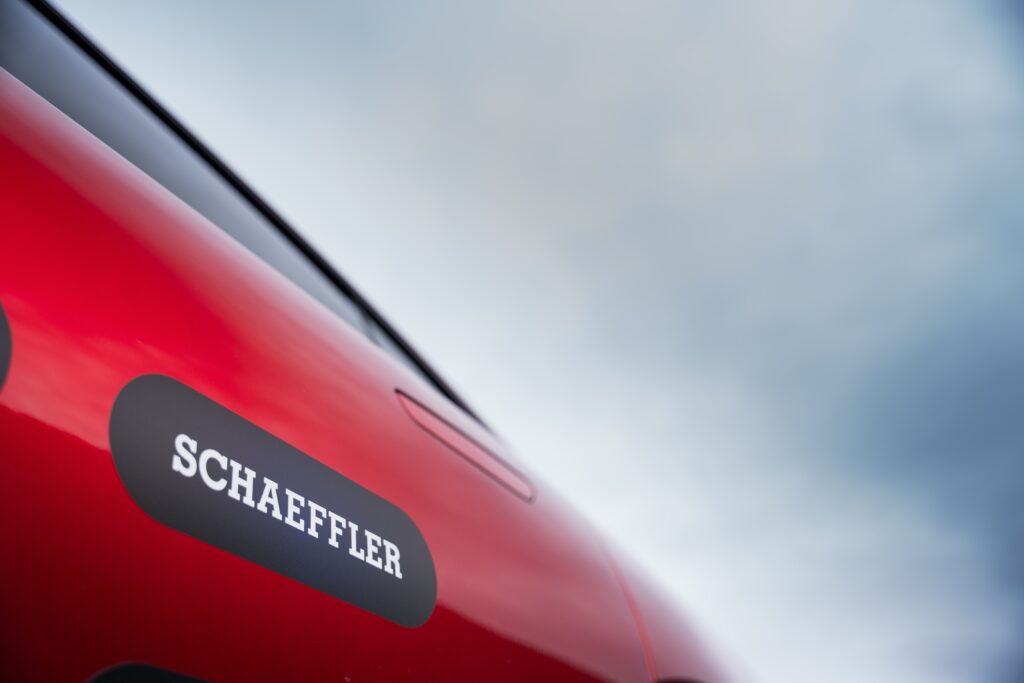
Marco Badea (Explicativ.com) on the Audi A6 Sportback e-tron
I climbed behind the wheel of the Audi A6 Sportback e-tron and set off for the Swiss passes. After a couple of kilometers I had the feeling that I was not testing this car, but that I owned it and had been driving it for years. It’s so easy to drive, so intuitive and so agile on the road that it’s worth every penny.
It’s a powerful EV that won’t lie to you. What’s more, it looks good inside and out. It’s roomy, comfortable, has a very good sound system, the dashboard is friendly and neither visually nor technically intrusive, and the safety assistant can even help you avoid getting a ticket on Swiss roads for speeding two or three kilometers per hour over the speed limit.
The Audi A6 Sportback e-tron is, therefore, a long-distance car that you can drive across Europe without any problems. Why? Because it has a very good range. We had a range of about 600 km at an average consumption of about 16 kWh/100 km. And we also drove on the highway and on three Swiss mountain roads that look like they were painted in AI or straight out of heaven.
I would liken this car to a tango dancer, who knows her steps very well and when she gets moving, she keeps the rhythm of the dance, but also of the song, perfectly. It’s a pleasure to drive this car, you feel like you are its partner and you dance with it on the road together while others watch.
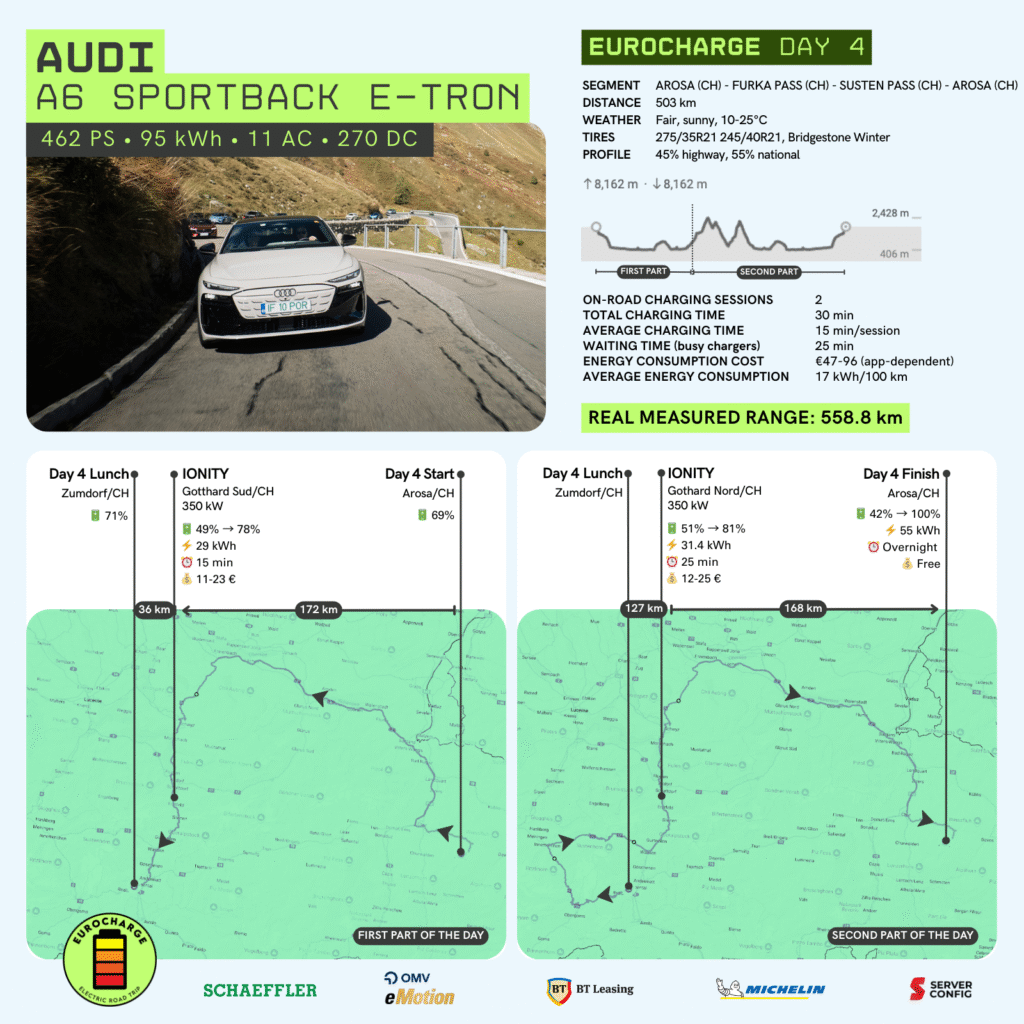
Radu Gurămultă (Autocritica) on the BYD Seal
This Build Your Dreams motto seems to have been taken as seriously as possible with the Seal. First of all, I really appreciate that there is an interesting sedan on the market; I’m one of those people who want to breathe beyond the SUV/crossover fever.
Then, I sat for a couple hours while driving and thought about the shortcomings of this model; and I say it as honestly as I can that I didn’t come across anything that flagrantly bothered me. That’s not to say that automatically if you got a BYD Seal everything would be flawless, it’s just that I didn’t discover its Achilles tendon. My first impression after a good few hundred miles of interaction is that the Seal presents itself as a mature, well-put-together model with plausible reasons to issue some claims in the car market.
If I have praised the bodywork version, I will be more reserved in my expression about the design. Somehow, I don’t see it as a beauty to be refined over time, but this aspect has a strong dose of subjectivity. Instead, I quickly fell quickly into the interior’s traps. An ergonomics that seems to have been learned from German professors, and the selection of materials and textures is also a big thumbs down, totally surprising for those who are currently afraid to taste the truffles that the Chinese industry is putting on the table. From this point of view, the Tesla Model 3 might have something to worry about. Especially since the interaction with the digital side of the Model Seal’s spirit is also friendly, quick to learn.
The range, a topic of interest, is fair for the technical proposal BYD is making, and the purchase price (€42,700 for the base version, €50,900 for the top version, tested by us in EUROCHARGE) is a fair reflection of current market realities. Now I’m not saying that the Seal is cheap, but that it becomes very interesting when you pragmatically debate competing offers. Shoulder to shoulder honestly, that is.
However, I would also have the necessary objection that I don’t want to make a statue of it. I’ve looked a couple of times for the promised 530 hp of maximum power and they’re nowhere to be found. Or, in fact, they’re not as impressive as they once were. That was a figure that used to make many sports cars shudder. Anyway, the dynamic resources are plenty, but not scary, to say the least. Still, for pumped egos, the Seal proudly wears its dry 0-60mph sprint time on its trunk lid: 3.8. Three point eight seconds, that is.
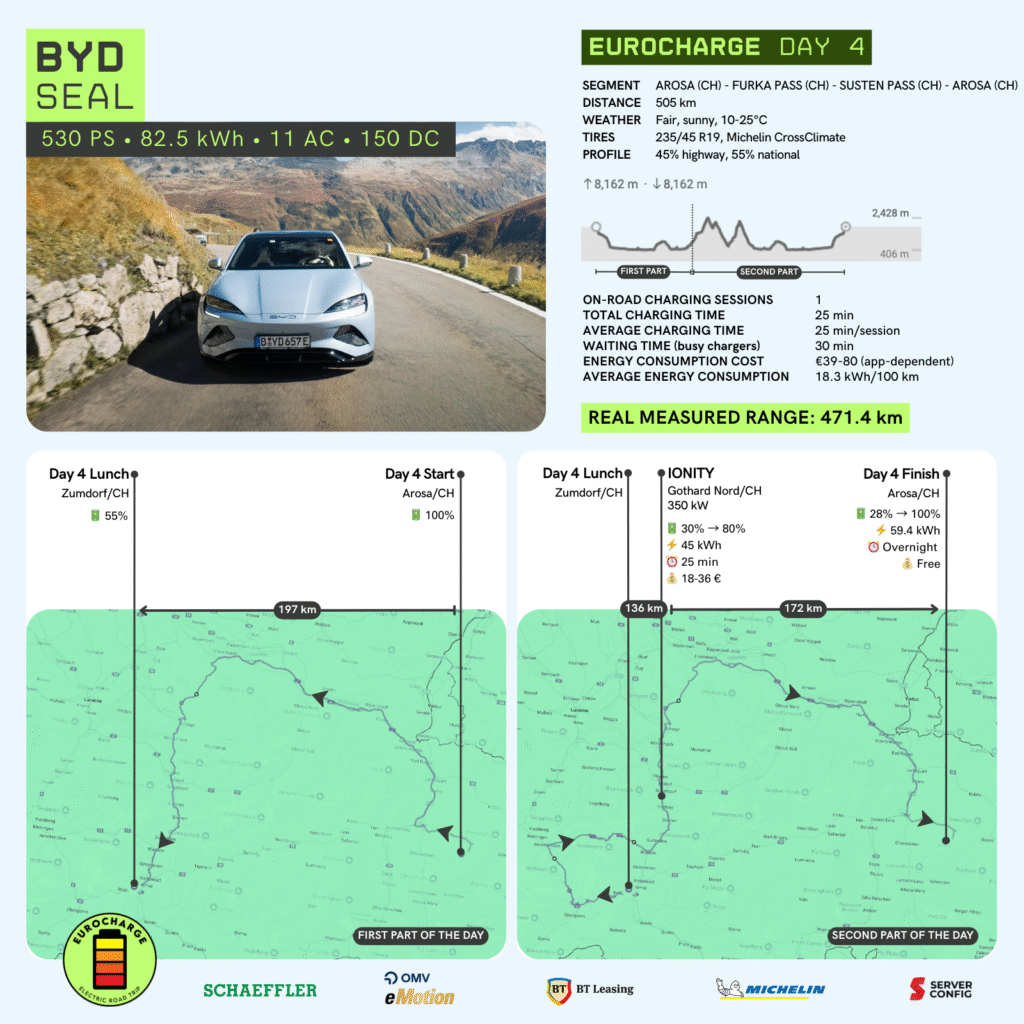
Cornel Șocariciu (Autocritica) on the Hyundai Inster
A car, regardless of the purpose for which it was developed, should be able to outdo itself and perform, sometimes even in less than favorable scenarios. We’ve seen record-breaking SUVs at the Nurburgring, but we’ve also seen electrics that have ridden to the ends of the earth and back. Therefore, I don’t think a Hyundai Inster on the Furka Pass should raise eyebrows any more. Be honest, on your vacations, how many times have you not encountered small or subcompact cars that carried their “masters” with ease?
For me, the Inster is no surprise. The Asian manufacturer needed a representative in the small-mini area, and with the experience gained from the Kona and Ioniq projects, Hyundai couldn’t do much wrong. Strengths? Efficiency: the car is light and manages to make diligent use of every kWh of energy, resulting in a good level of efficiency and a decent range for the battery capacity. For those who still doubt our experiments, I’ll tell you this: there wasn’t a moment that I thought about range or the rest of the battery. I enjoyed the alpine passes in Switzerland, period.
Then there’s space. In general, models in this segment might scare off those suffering from claustrophobia. Not the Inster. The crossover shape (slightly atypical for its segment) and the large windows manage to add to the atmosphere inside. Of course, the minuses come when elbows with your tour-mate get annoying or knees don’t find the most relaxed position.
Also in the plusses, I’d also include the dashboard transplant from the bigger Ioniq siblings. Obviously, elements were lost during the operation, but the perceived quality is not to be neglected. The rest of the interior, on the other hand, is exactly as you’d expect it to be: lots of plastic (but with good textures) and door fronts that could have done with a bit more sound-absorbing material. If I’m allowed one more tug of the sleeve: the steering wheel seems oversized for the Inster’s interior.
I’ve saved for last the cherry on top of the cake I envisioned: the pepita upholstery. Not only do I like it, but I’d give an idea to car manufacturers: let them sell in furniture stores the seats they put in their cars (adapted, obviously, to a different use). Because if that were the case, tomorrow I’d get two just like the ones on the Insterul in EUROCHARGE.

Gabriel Nica (Cu și Despre Mașini) on the Mazda 6e
After 500 kilometers on some of Switzerland’s most breathtaking roads, the Mazda 6e demonstrated its qualities in a setting that took my breath away at times. And it wasn’t because of the thin air. Let’s start with the good bits.
The quality of the interior is without doubt the strong point of this car. The materials used are outstanding and the assembly is impeccable. The surface touch and finishes give a feel that you find on genuine premium models that evolve into entirely different spheres when it comes to the price paid. In fact, I’d say it surpasses them on many occasions.
Another genuine surprise was the road holding. On the twisty roads of the Alps, the Mazda 6e behaved exemplary, demonstrating a very good balance between comfort and sportiness. The car inspires confidence when cornering and the response to the controls is precise and predictable. You can make it oversteer and you’ve certainly never been able to do that in a Mazda6 before. The torque delivered instantly and copiously made me re-evaluate every corner on the climb to Furka pass.
And that’s not all. Charging also worked as it was supposed to. In just 17 minutes we added over 200 kilometers of range – a performance that should take some of the worry off the autonomy of some who think electric cars are just about driving to the Mall and back.
What about the design? I think it’s obvious that it’s the best looking car on this tour, right? Or maybe just to me. It’s okay, I accept that.
But not everything is perfect. While the new Mazda6e is a step up in size, some of the modern car’s shortcomings have made their way on board. Ergonomics unfortunately suffer, with many controls being moved to the ubiquitous screens found in cars today. The driving position isn’t ideal either, with the driver’s seat positioned a little too high for me at 184 cm tall.
Still, Mazda’s new electric sedan is likely to prove a hit. Why? Well take a look at it! That’s all you have to do. And the performance combined with the eye-catching shape and especially the Soul Crystal Red color will be decisive.
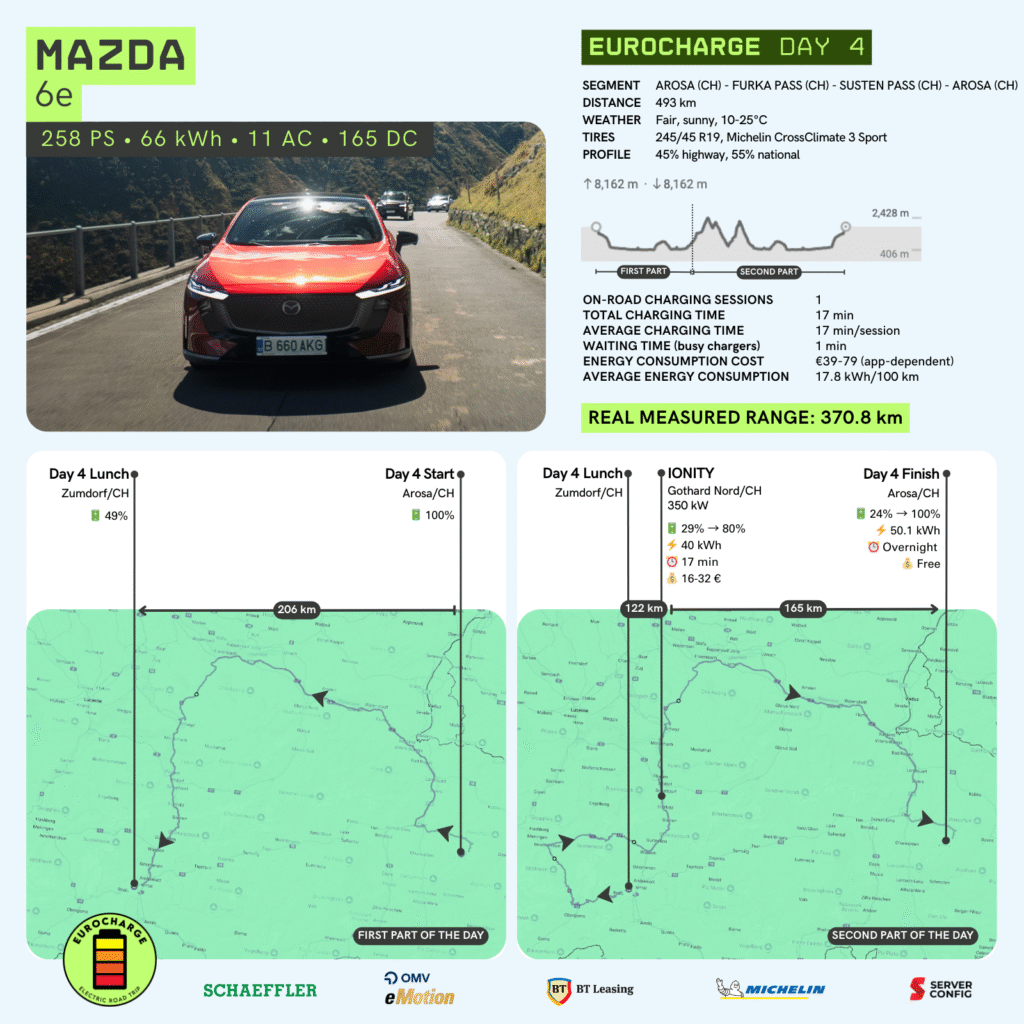
Tibi Buzdugan (Electromobilitate.com) on the Porsche Macan
The day we had Switzerland’s trio of Alpine passes on the menu was spent behind the wheel of a Porsche Macan. I don’t know if there’s any car on the tour more suited to the route we traveled. We started with 45 minutes of meandering to Chur, then 100+ km of highway, twisty roads in and out of passes and back to the starting point. So basically every kind of road you could use a car on. So I can say that there is no situation for which a Macan wouldn’t be suitable.
As the brand’s first electric SUV, the car greatly increases the number of people who would be willing to transition to an electric car. It doesn’t have any minuses that you could blame to put off the decision: it charges extremely quickly, it’s fairly hard to unload, it’s extremely efficient, and it definitely needs breaks from the road less often than you do, whatever your driving style. Sure, there are people who say they’ll only go electric when it’s going to get 1000km range and charge in 3 minutes, but so are people who say they’d rather have a more solid horse than a Ford T.
I have thought a lot in the 400 kilometers I have been driving the car, what I could say bad or, to put it another way, what I would change about the car. And the only thing that I found a little unfortunate is the way the center console is cut out. The storage space in it isn’t very practical, and plugging cables into the ports underneath the multimedia area is a test of dexterity for any more solid hand.
Otherwise, all good. On the long haul, the car is like a floating carpet. It’s supremely comfortable, reasonably well soundproofed, has assistance systems and headlights that make life easier when you have long days behind the wheel. When you leave the highway and hit the mountain roads, the car feels like a minicar and makes you forget it’s an SUV. It corners very well, has enough torque and power to overtake at your leisure, and doesn’t make you feel afraid when you’re out for a bit on the macadam or in a gravel and boulder-strewn parking lot (which I would feel in a Taycan, for example).
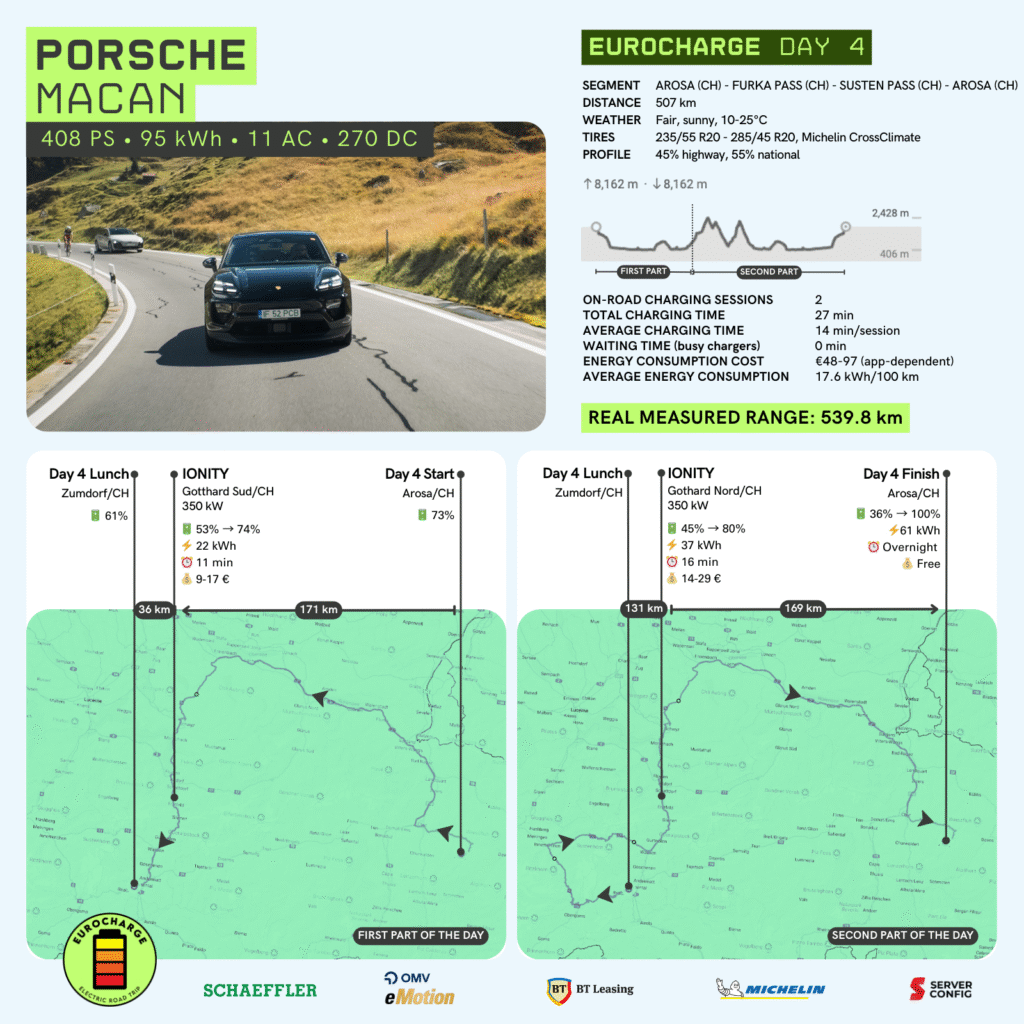
Alin Ionescu (Mașinistul) on the Renault 4 E-Tech Electric
Hi, I’m The Machinist and I love classic cars. Perhaps for that reason (but also because of other attributes I’ll detail below), I clicked on the new Renault 4. Because it’s an electric car that pays tribute to history. And it does it so well, so naturally, that it feels like much more than a marketing gimmick.
This retro-futuristic design recipe is not new, but it doesn’t always work. We have many examples of this, but also many dismal failures. Even in this era of transition to electric propulsion, several manufacturers have resurrected resonant names to launch models that bear no relation to their predecessors. Fortunately, that’s not the case here.
The Renault 4 is not only reminiscent of the ‘Quatrelle’, but also practical. The 5’s big brother (also electrically reborn) manages to be more of an urban vehicle, its 2.6-meter wheelbase leaving more room for rear passengers, but especially luggage. It’s still cramped in the back for the ideal family car, but where front-seat occupants don’t exceed 5’7″ in height, there’s decent knee room for those in the back seat.
The French have taste when it comes to combining modern technology (generous on-board screens, Android Auto, efficient assistance systems) with retro materials and shapes. Like the exterior, the interior of the Renault 4 is very pleasant, reminiscent in places of the original 1961 model. When it comes to retro-inspired design, the line between good taste and kitsch is very fine. The French have really done an excellent job.
With 150 hp and a 1.5-tonne kerb weight, it moves well. It’s also very pleasant to drive, the soft controls needing only a short getting used to. The suspension is excellently tuned (it also helps that it’s not a very heavy car like most electrics), the steering is confident, the moderate roll conveys the car’s intentions very well, and the ride comfort is remarkable. Writing these impressions after a day of driving through three of Switzerland’s most beautiful mountain roads, it’s clear that Renault has made a good car dynamically as well.
But as nobody’s perfect in this world, the 4 isn’t without its weaknesses either. One of them would be the battery capacity, which, at 52 kWh usable, is only enough for 250 km in highway mode. Nor is the maximum charging power of 100 kW something to brag about in 2025. But in a mixed-use, predominantly urban, extra-urban commute of a few dozen kilometers a day, with slow overnight or office charging, the Renault 4 could be not only the perfect car, but also a reason to smile every day.

Constantin Ciobanu (Autocritica, Adevărul) on the Volkswagen ID.4
Volkswagen ID.4 is to me a dish that you once tasted, liked, but the chef hadn’t found that fine balance of ingredients to make it memorable. But here I am with that dish again, did the chef learn anything from the feedback from the dining room?
Absolutely yes! The massive plus, or I wouldn’t exactly call it an evolution because things are totally different, is in the chassis, the way the ESP system is calibrated and how kWh is converted into dynamic performance.
Although with an obvious SUV allure, the suspension achieves a very good mix of comfort and effective roll and mass control. Moving on to the 286bhp and 545Nm, I’d say things are radically different to what I initially found with this model when it was launched. You have access to unrestricted power from the ground up, initially this was done gradually, somewhere around 70 km/h you felt like you were getting all the horsepower you bought. So, yes, the 286 horsepower is there from the first few inches an hour. The car is infinitely more efficient in sending the power to the ground, here the Michelin CrossClimate tires probably have something to say. But an extremely interesting detail, the rear axle is so efficient at putting the power down that if you accelerate violently out of corners you’re met with a little understeer caused by a violent transfer of mass to the rear, it’s like a dragster at the start. And the ESP is much more refined and fluid in its intervention.
The technical update received by the ID.4 would have been worth a little more if it had been accompanied by the elimination of ergonomic shortcomings such as the two buttons that control the opening of the front/rear side windows after selecting the area of interest. The infotainment system wins with the new center display that has a new operating system behind it, but I still ran into minor syncing syncing hiccups on Apple CarPlay.
A white marble for storage, and space in general on board the ID.4
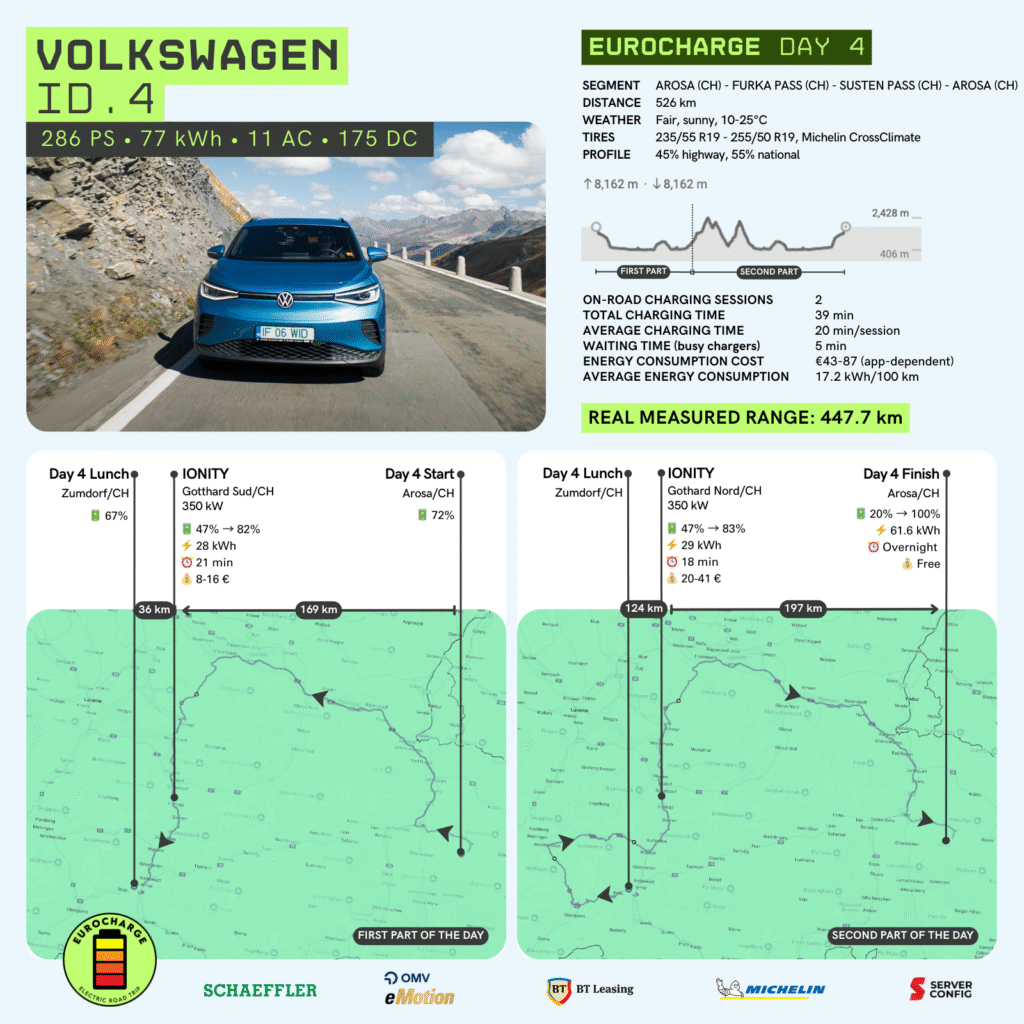
Mircea Meșter (Autocritica) on the Volvo EX90
The Volvo EX90 carries forward into the electric age the idea of the apartment on wheels that its still-relevant ICE sibling, the XC90, has been carefully building for years. Basically, it’s the kind of car you get in and wonder if you need a building permit, not a driver’s license. It is, by far, the bulkiest, tallest and heaviest car on our tour, a Scandinavian packet on the road.
With that in mind, I set off on the road over three Swiss passes: Furka, Grimsel and Susten. Except that after the first 20 kilometers of winding roads, I completely forgot I was behind the wheel of a 2.7-ton SUV. I found myself instinctively ‘cruising’ the corners (with sense), the car ‘hugging’ me and listening to my commands. For a nearly 5-meter car, the EX90 is shockingly agile and dynamically well-tuned when your ride is a ride, not a special rally test.
Of course, physics never forgives anyone. On the way down, you feel the inertia of the gauge, which would throw you on your nose if you were reckless. On the plus side, Volvo has turned gravity into a super-charger. On the spectacular 18-kilometer descent of the Susten Pass, a visual ecstasy I recommend to anyone in need of natural therapy, the EX90 put no less than 8 percent back into the 107 kWh battery! That’s about 8.5 kWh. In English, it charged itself, from the brakes, faster than an 11 kW AC station at home or at the hotel.
In atmosphere, the EX90 is a mix of a Swedish house on the edge of a forest and the angular architecture of an Oslo concert hall. First contact with the minimalist interior is a mixture of confusion and awe. Where are the buttons? Why is cruise control activated by pressing the gear lever down, like some kind of technological hide-and-seek? But once you’ve befriended the Swedish logic, there’s a revelation. It’s simple. The little screen in front of you gives you exactly what you need, clearly and concisely. And that huge tablet in the center is like Tesla, only better. If only because it has Apple CarPlay seamlessly integrated and Google Maps native.
And then there’s the comfort. The seats are so good, you get out more rested than you got in. The massage function has been abused on the highway, I admit, taking care of my labored back. The space is monumental – between my crest and the ceiling I think I can fit a head. And the materials are a lesson in design: wool, recycled textiles, fine eco-leather. A mobile Scandinavian living room. A huge cue ball for the Bose basic audio system, which sounds unexpectedly good. I can’t say it’s not worth breaking the bank for Bowers & Wilkins, the top option, but you’ll get good music anyway.
And after all that running, with three passes and highways, consumption: 19 kWh/100 km. A marvelous figure for how much shade this car gets on the road. Some 563 kilometers of real range calculated on what we did and crossed yesterday. The most of any car on the tour.

